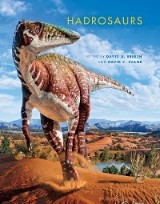Details

Hadrosaurs
Life of the Past
|
9,49 € |
|
| Verlag: | Indiana University Press |
| Format: | EPUB |
| Veröffentl.: | 05.11.2014 |
| ISBN/EAN: | 9780253013903 |
| Sprache: | englisch |
| Anzahl Seiten: | 640 |
DRM-geschütztes eBook, Sie benötigen z.B. Adobe Digital Editions und eine Adobe ID zum Lesen.
Beschreibungen
<p>Hadrosaurs—also known as duck-billed dinosaurs—are abundant in the fossil record. With their unique complex jaws and teeth perfectly suited to shred and chew plants, they flourished on Earth in remarkable diversity during the Late Cretaceous. So ubiquitous are their remains that we have learned more about dinosaurian paleobiology and paleoecology from hadrosaurs than we have from any other group. In recent years, hadrosaurs have been in the spotlight. Researchers around the world have been studying new specimens and new taxa seeking to expand and clarify our knowledge of these marvelous beasts. This volume presents the results of an international symposium on hadrosaurs, sponsored by the Royal Tyrrell Museum and the Royal Ontario Museum, where scientists and students gathered to share their research and their passion for duck-billed dinosaurs. A uniquely comprehensive treatment of hadrosaurs, the book encompasses not only the well-known hadrosaurids proper, but also Hadrosaouroidea, allowing the former group to be evaluated in a broader perspective. The 36 chapters are divided into six sections—an overview, new insights into hadrosaur origins, hadrosaurid anatomy and variation, biogeography and biostratigraphy, function and growth, and preservation, tracks, and traces—followed by an afterword by Jack Horner.</p>
<p>Preface<br>Part I—Overview<br>1. A history of the study of ornithopods. Where have we been? Where are we now? and Where are we going?<br>Part II—New Insights into Hadrosaur Origins<br>2. Basal Neoiguanodontians from the Wealden of England: Do they contribute to the discussion concerning hadrosaur origins?<br>3. Osteology of the basal hadrosauroid Equijubus normani from the Early Cretaceous of China<br>4. A new basal hadrosaurid dinosaur, *** (Lü, 1997) comb. nov., from the Early Cretaceous of Gansu Province, China<br>5. Postcranial anatomy of a basal hadrosauroid from the Cretaceous Woodbine Formation of Texas <br>6. A re-evaluation of purported hadrosaurid dinosaur specimens from the 'middle' Cretaceous of England<br>7. A new hadrosauroid * * * from the Late Cretaceous Djadokhtan fauna of Mongolia<br>8. Hadrosauroid material from the Santonian Milk River Formation of Alberta, Canada<br>Part III—Hadrosaurid Anatomy and Variation<br>9. New hadrosaurid specimens from the lower-middle Campanian Wahweap Formation of Utah <br>10. New saurolophine material from the upper Campanian-lower Maastrichtian Wapiti Formation, Alberta <br>11. Variation in the skull roof of the hadrosaur Gryposaurus illustrated by a new specimen from the Kaiparowits Formation of Utah <br>12. A skull of Prosaurolophus maximus from southeastern Alberta and the spatiotemporal distribution of faunal zones in the Dinosaur Park Formation <br>13. Postcranial anatomy of Edmontosaurus regalis from the Horseshoe Canyon Formation, Alberta<br>14. Cranial morphology and variation in Hypacrosaurus stebingeri <br>Part IV—Biogeography and Biostratigraphy<br>15. An overview of the latest Cretaceous hadrosauroid record in Europe. <br>16. The hadrosauroid record in the Maastrichtian of the eastern Tremp Syncline (northern Spain) <br>17. Hadrosaurs from the Far East: historical perspective and new Amurosaurus material from Blagoveschensk (Amur region, Russia) <br>18. South American hadrosaurs: considerations on their diversity <br>19. The hadrosaurian record from Mexico<br>20. Stratigraphic distribution of hadrosaurids in the Upper Cretaceous Fruitland, Kirtland and Ojo Alamo formations, San Juan Basin, New Mexico<br>21. Relocating the lost Gryposaurus incurvimanus holotype quarry, Dinosaur Provincial Park<br>Part V—Function and Growth<br>22. Comparative ontogenies (appendicular skeleton) for three hadrosaurids and a basal iguanodontian: divergent developmental pathways in Hadrosaurinae and Lambeosaurinae 23. The size-frequency distribution of hadrosaurs from the Dinosaur Park Formation of Alberta <br>24. Osteohistology and occlusal morphology of Hypacrosaurus stebingeri teeth throughout ontogeny with comments on wear-induced form and function <br>25. Three-dimensional computational modeling of pelvic locomotor muscle moment arms in Edmontosaurus and comparisons with other archosaurs <br>26. Duckbills on the run, the cursorial abilities of hadrosaurs and implications for tyrannosaur-avoidance strategies <br>27. Duck soup: the floating fates of hadrosaurs and ceratopsians at Dinosaur Provincial Park <br>28. Hadrosauroid jaw mechanics and the functional significance of the predentary bone <br>Part VI—Preservation, Tracks, and Traces<br>29. Debris flow origin of an unusual Late Cretaceous hadrosaur bonebed in the Two Medicine Formation of Montana <br>30. Occurrence and taphonomy of the first documented hadrosaurid bonebed from the Dinosaur Park Formation at Dinosaur Provincial Park<br>31. Body size distribution in a death assemblage of a colossal hadrosaurid from the Upper Cretaceous of Zhucheng, Shandong Province, China <br>32. First hadrosaur trackway from the Upper Cretaceous Oldman Formation, Alberta<br>33. Paleopathology in Late Cretaceous Hadrosauridae from Alberta<br>34. A review of hadrosaurid skin impressions <br>35. Soft-tissue structures of the nasal vestibular region of saurolophine hadrosaurids revealed in a 'mummified' specimen of Edmontosaurus annectens <br>36. The role and biochemistry of melanin pigment in the exceptional preservation of hadrosaur skin <br>Afterword<br>Index</p>
<p>David A. Eberth is a senior research scientist at the Royal Tyrrell Museum in Drumheller, Alberta, Canada.</p>
<p>David C. Evans is a Curator in Vertebrate Paleontology at the Royal Ontario Museum and an Associate Professor in the Department of Ecology and Evolutionary Biology at the University of Toronto.</p>
<p>David C. Evans is a Curator in Vertebrate Paleontology at the Royal Ontario Museum and an Associate Professor in the Department of Ecology and Evolutionary Biology at the University of Toronto.</p>
<p>Hadrosaurs have not had the wide publicity of their flesh-eating cousins, the theropods, but this remarkable dinosaur group offers unique opportunities to explore aspects of palaeobiology such as growth and sexual dimorphism. In a comprehensive collection of papers, all the hadrosaur experts of the world present their latest work, exploring topics as diverse as taxonomy and stratigraphy, locomotion and skin colour.</p>

















